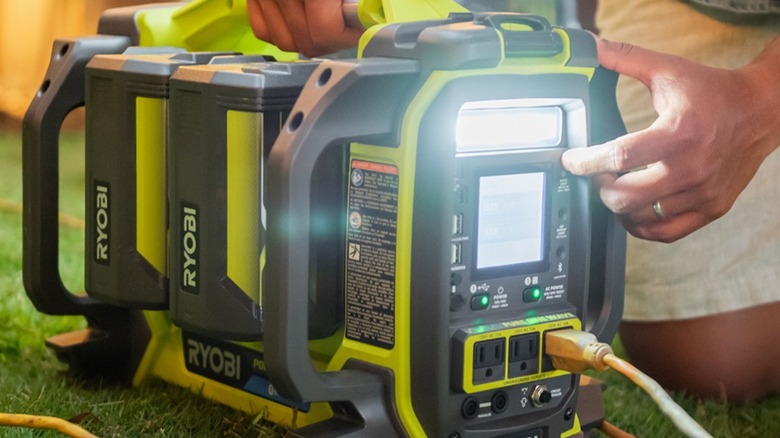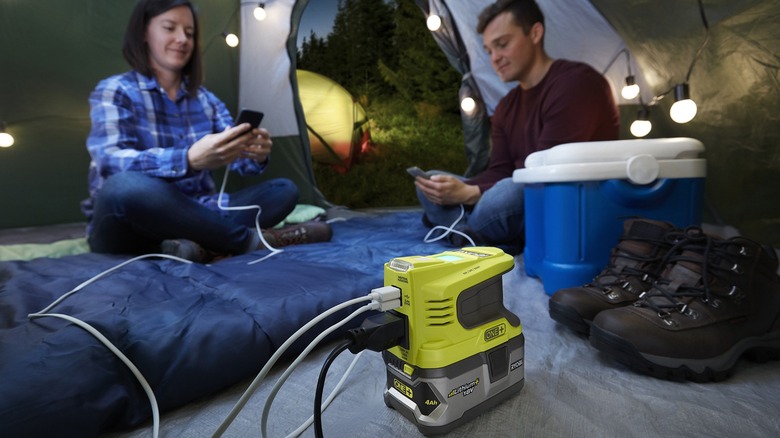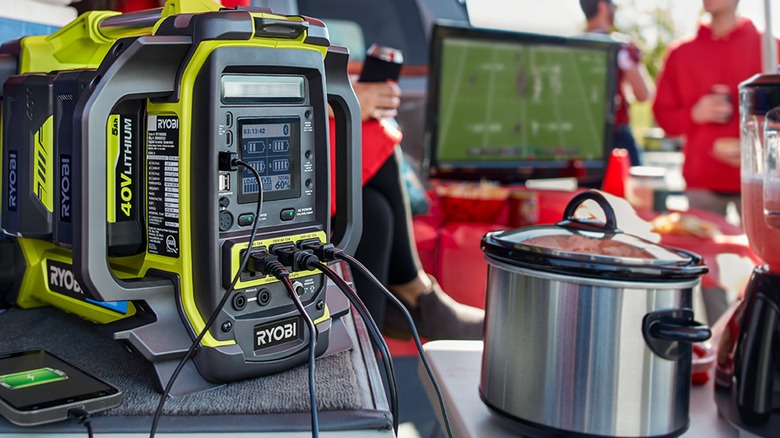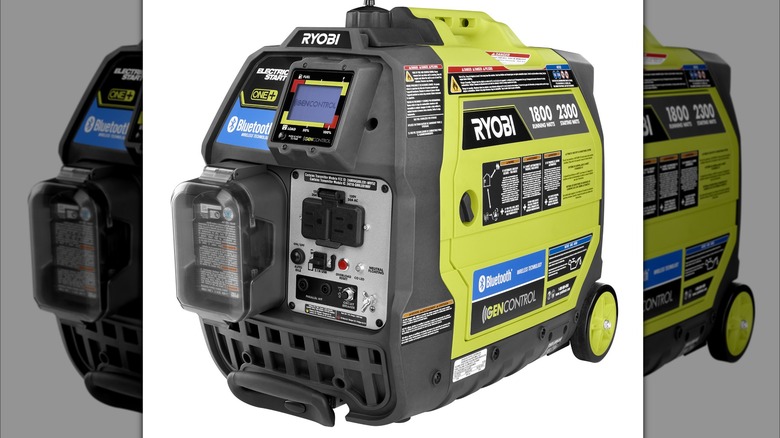Ryobi Power Source Vs. Power Station Vs. Generator: What's The Difference?
Some people may worry that power stations are just overpriced gadgets, but having portable electrical power while camping or living off-grid, or simply using one when experiencing a power outage at home, can be a big difference. Whether you rely on powered medical devices like CPAP machines, are using power tools to build an off-grid cabin, or enjoy watching your favorite sporting events at your campsite, Ryobi offers multiple methods to power those endeavors.
Along with other high-tech Ryobi products you might not know existed, the company provides power storage and generation devices like the Power Source, Power Station, and a line of gas-powered generators. These Ryobi power options provide options to plug in various power cords including standard 120-volt AC appliances, USB-A, USB-C, and, in some cases, 30-amp RV plug-ins.
Ryobi's Power Source units use the company's battery systems to provide portable electrical power. Ryobi's Power Stations are more robust systems, delivering up to 1800 watts of continuous portable power and smartphone connectivity. While the Power Source and Power Station options simply transfer or store electricity, Ryobi's gas-powered generators make electricity to be used or stored by other devices. Ryobi provides several gas generator options, but inverter-type generators are typically best suited for powering most types of electronics, so we'll focus on those.
Ryobi Power Source
By itself, the Ryobi 18V ONE+ 150-watt Power Source at $49 MSRP sans battery, isn't much more than a bright green and black paper weight. However, attaching a 4Ah Ryobi 18V ONE+ battery allows it to power and charge electrical devices like phones, laptops, tablets, and fans. It can power a 32-inch television for up to two hours. Other Ryobi 18V ONE+ batteries will also work, but lower capacities will result in less time the Power Source can power or charge your devices.
In addition to the modified sine wave 120-volt AC outlet, the Ryobi 18V Power Source provides two USB-A charging ports with 5-volt DC and 2.4-amp shared output. While that's enough to power up a small television, it's important to understand the limitations of the Ryobi Power Source.
The 120-volt AC outlet on the Ryobi 18V Power Source is rated for 150 watts of continuous output. At 120 volts, that equates to the listed spec of 1.25 amps. To prevent potential disappointment, don't plan to power electrical devices with high power demands, hair dryers, space heaters, coffee makers, etc., with the Ryobi 18V Power Source.
While it still won't power your coffee maker, the Ryobi 40V Power Source delivers 300 watts (2.5-amps) of continuous pure sine wave 120-volt AC output. While the 40V Power Source only provides one USB-A outlet, it's rated at 3 amps by itself and there's an additional USB-C outlet that provides up to 20 volts and 2 amps.
Ryobi Power Stations provide more power options
With an MSRP of $849, the 40V 1800-watt Power Station Kit from Ryobi includes two 6Ah 40-volt Lithium batteries that can either be charged by the Power Station when it's plugged in to grid power, or used to power the Power Station for off-grid use. If you've already invested in Ryobi 40V batteries, the Power Station is available for purchase as a "Tool Only" option at $649 MSRP.
Likewise, Ryobi offers the 18V ONE+ 1800-watt Power Station without batteries as a "Tool Only" option for $649 MSRP, or as a kit with four 6Ah 18V batteries for $849 as well. The 18V Power Station includes an adaptor for charging 18V ONE+ batteries. Users can monitor up to two 18V or 40V Power Stations from a smartphone using the GENControl app.
The final 1,800-watt Power Station option from Ryobi, MSRP $1,199, includes an internal battery capacity of 1,094 watt-hours, which Ryobi claims is enough to power a full-sized fridge for up to 18 hours. The unit is capable of providing 3,000 starting watts and 1,800 watts continuously. The 18V Power Station equals that output, but the 40V Power Station specs limit the 1,800-watt output to three minutes with 1,600 watts continuous.
While only the 18V Power Station features a solar panel charging option, all three offer multiple 120-volt, USB-A, and USB-C outlets. They are also Parallel Capable, allowing compatible units to be connected, doubling the power.
Ryobi's gas-powered generators
Ryobi lists five gas-powered generators on its website ranging from 2,300 watts to 6,800 watts with MSRP from $643.64 to $899.00, however, the generated watts don't necessarily correspond to the price point. For example, the $849 inverter generator produces 2,300 starting watts with 1,800 watts continuous, whereas the $799 inverter generator provides 4,000 starting watts with continuous output rated at 3,400 watts.
Of course, the value of a generator isn't solely based on watts, features are also important. The Ryobi 2,300-watt inverter generator is a good example. Its included 18V ONE+ 1.5Ah battery provides power to the built-in electric starter, which can be controlled remotely from the GENControl app. The generator also retains pull-cord start capability as a last resort, and if 2,300 watts isn't enough for your needs, its parallel capability doubles its output.
The larger Ryobi 4,000-watt inverter generator doesn't offer electric start, Bluetooth connectivity, or parallel operation, but it does have a CO Detect Shutdown Sensor and idle-down technology to reduce fuel consumption and noise during periods of low demand. Ryobi's inverter generator options provide enough power to support nearly any 120-volt appliance in your home or at camp.



